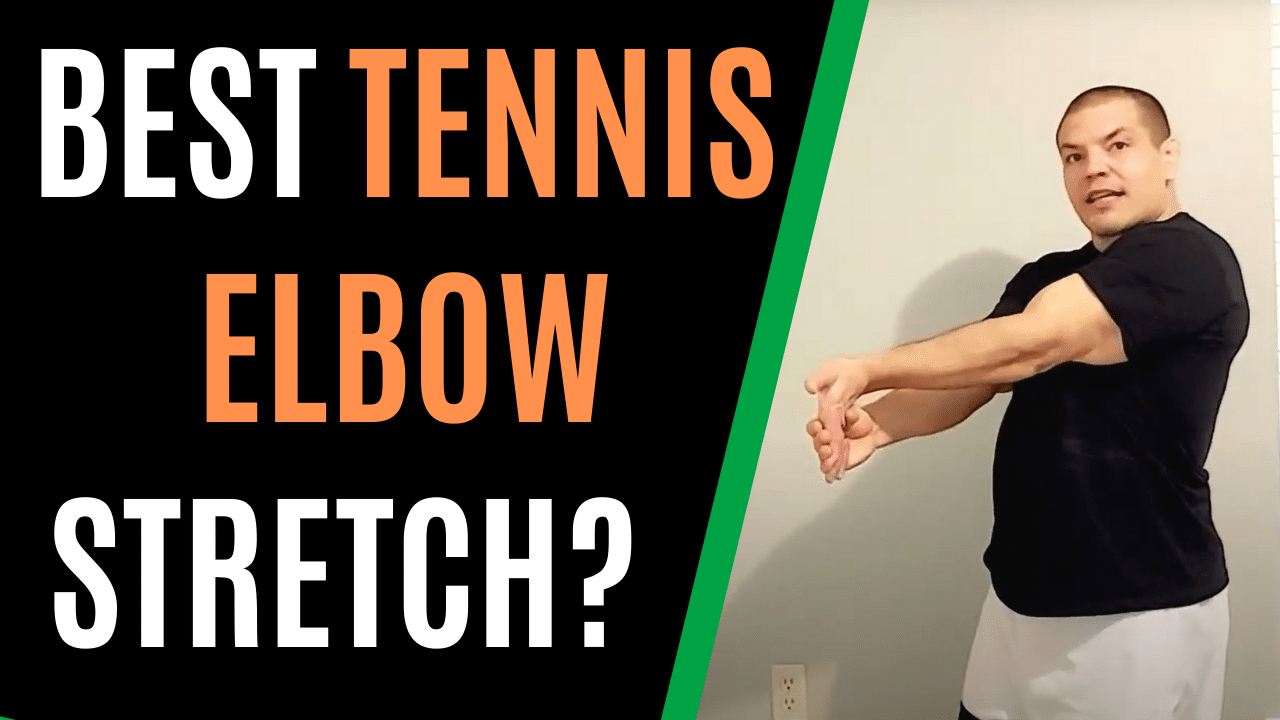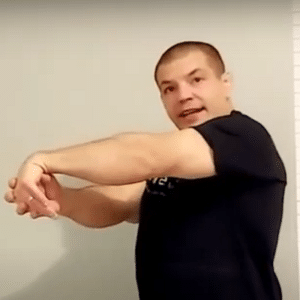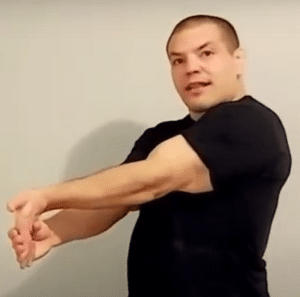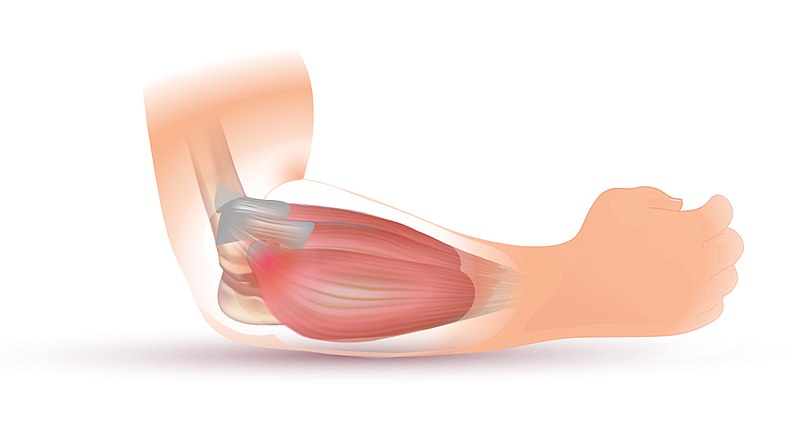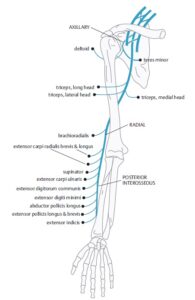Want To Learn The Best Tennis Elbow Stretch?
It may depend on what type of tennis elbow you have.
Watch the video to learn little-known tennis elbow stretch secrets, plus what mistakes to avoid.
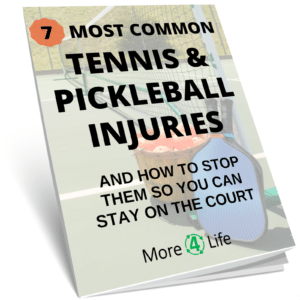
What's The Best Tennis Elbow Stretch?
You may think Tennis Elbow, or pain on the outside of the elbow, or lateral epicondylitis as medical folks call it is all one thing.
However, there are actually 2 different kinds of tennis elbow, as well as other things that can cause pain on the outside of the elbow that can feel similar to tennis elbow.
You Mean Tennis Elbow vs. Golfer's Elbow?
Actually no.
If you've had tennis elbow for awhile, you may have read about tennis elbow vs. golfer's elbow.
Tennis elbow refers to pain on the outside of the elbow and golfer's elbow refers to pain on the inside of the elbow.
I'm not talking about tennis elbow vs. golfer's elbow though.
I'm actually talking about 2 different kinds of tennis elbow.
And as you might expect, the tennis elbow stretch that is best is not the same for each time.
Two Different Types Of Tennis Elbow?
Yes, you read that right.
And you probably won't read about it in too many other places, so keep reading.
Before getting too far into the specifics of the two different types of tennis elbow, you first need to understand the scientific naming of them. Generally, pain on the outside of the elbow is scientifically referred to as lateral epicondylalgia. (lateral = outside, epicondyle = bump on the side of the elbow, -algia = pain). It literally means "pain in the bump on the outside of the elbow".
Tennis elbow is most commonly called lateral epicondylitis, (-itis = inflammation) meaning "inflammation of bump the outside of the elbow"
However, there is another, more common form of tennis elbow that usually occurs in people who don’t even play tennis where there is pain on the outside of the elbow without inflammation! This condition is called lateral epicondylosis (-osis = an abnormal condition of) or lateral epicondylopathy (-pathy = pathological condition of).
We'll get to that one further down the page, but first we'll discuss the traditional lateral epidondylitis type of tennis elbow.
Tennis Elbow Stretch For Lateral Epicondylitis
Going back to lateral epicondylitis, this means that inflammation is present in tendon that is attached to the outside of the elbow.
The wrist extensor muscles and the forearm supinator muscles attach to the lateral epicondyle - the bump on the outside of the elbow.
What Causes Lateral Epicondylitis?
Lateral epicondylitis, the inflammatory kind of tennis elbow, is usually caused by forceful wrist flexion and twisting motions such as when hitting a top-spin forehand or serve in tennis.
When making these quick, twisting movements with your arm, it rapidly stretches the tendon that attaches to the lateral epicondyle.
At the same time that these muscles are stretching, they are working eccentrically to slow down your forearm. That means the muscles are trying to shorten while at the same time, they're actually lengthening.
This cause microtears within the tendons, as well as within the sheath around the bone (the periosteum) that it attaches to.
Cortisone Injections For Lateral Epicondylitis
When there is inflammation in the elbow (lateral epicondylitis), steroid injections such as cortisone can help to reduce the inflammation.
However, it's a temporary solution and you still want to address the root cause of the problem so that the pain and inflammation don't come back in the future.
Do braces work for tennis elbow?
Tennis elbow braces do work to give some temporary relief from acute lateral epicondylitis. By applying pressure on trigger points in the wrist extensor / muscles ahead of where the tendon meets the elbow, it can allow the tendon to recover while you're searching out more lasting solutions.
If you need a tennis elbow brace, I would recommend the TENEX Elbow Shock Absorber brace. It helps absorb shock from the impact force of hitting a tennis ball or golf ball.
Again though, in order to get lasting relief from tennis elbow, you need to find the root cause of the problem and then fix it so that your tennis elbow doesn't keep coming back when you stop wearing the brace.
Want To Discover The Root Cause Of Your Tennis Elbow?
Click the button below to request a Free Discovery Visit
Avoid This Tennis Elbow Stretch With Lateral Epidondylitis
Because inflammatory lateral epicondylitis is caused by overstretching of the wrist extensor tendons, you DON'T want to further stretch the painful tissues.
This only causes further stretching of the already over-stretched tissues, and can actually make the problem worse.
Try the stretch below instead...
The Best Tennis Elbow Stretch For Lateral Epicondylitis
Instead of stretching to sore, inflamed muscles and making them even more sore and inflamed, try stretching the wrist flexor muscles on the opposite side of the forearm.
You can do this by simply pulling your hand up and backwards, so that your palm is facing out in front you.
Why is this the best tennis elbow stretch for lateral epicondylitis?
When you loosen up the muscles on the underside of the forearm, there is less resistance for the wrist extensor muscles to work against.
However, even MORE importantly than stretching, it's important to make sure you're using your whole body during a tennis, pickleball, or golf swing instead of making the forearm muscles to all of the work.
By doing this, you'll be less likely to get your elbow re-inflamed in the future.
Tennis Elbow Stretch For Lateral Epicondylosis
If you've been diagnosed with tennis elbow, you might wonder:
"How did that happen? I don't even play tennis!"
Lateral epicondylosis, the non-inflammatory type of tennis elbow, comes from doing repetitive, low-load activities over longer periods of time.
Examples of people who suffer from these types of problems may include include office worker or musicians who are do repetitive activities with their hands such as typing or playing an instrument
Your Muscles Are Suffocating
Repetitive activities with the hands can make knots develop within the forearm muscles. These knots, called trigger points, can reduce blood flow, and therefore oxygen to the tendons in the forearms.
Interestingly, it actually takes energy in order to relax a contracted muscle. In order to produce energy efficiently, your muscles need oxygen.
When the blood flow to your forearm muscles and tendons is restricted, your muscles don't get the oxygen they need. Thus, it can be hard for them to relax.
The harder it is for your muscles to relax, the less blood flow they get... which makes it even yet harder for them to relax.
A Vicious Cycle
Now, your muscles can produce energy without oxygen in a very inefficient process called anaerobic glycolysis. (Remember that one from biology class?) However, one of the bi-products of that process is lactic acid, the same pain-provoking chemical that causes you to "feel the burn" when you're working out.
And the energy produced from this process still isn't enough to allow your forearm muscles to relax.
This vicious cycle leads to a buildup of chemicals around the trigger point that can cause pain.
Treatments like manual trigger point therapy or dry needling can help break this vicious cycle.
Additionally stretching the wrist extensor muscles that contain the trigger points can help.
Tennis Elbow Stretch For Lateral Epicondylosis
Remember the tennis elbow stretch that we said NOT to do for lateral epicondylitis?
Well, that's actually a very effective stretch for non-inflammatory tennis elbow.
Here are a few expert secrets to make this tennis elbow stretch more effective:
- Hold your arm straight out in front of yourself with your palm down
- Use your other hand to pull down on top of the wrist, only until you feel a mild stretch in the top of the forearm
- Pro tip #1: If you feel pain or feel pulling in the tendon by the elbow, you're going too far. You should feel this stretch in the forearm muscle belly, NOT the elbow.
- Pro tip #2: Keep the thumb of the opposite hand that you're not stretching along the wrist line as shown in the picture above. This acts as a fulcrum to bend your wrist around and can help if you have a stiff wrist joint (which many people with tennis elbow do).
- Pro tip #3: Try the stretch with the fingers straight and also with the fingers curled. Both your finger extensors and wrist extensors can be involved in tennis elbow. When you curl the fingers, you stretch the finger extensor muscles and you may notice you can't stretch as far.
Aerobic Exercise For Your Elbow?
Because non-inflammatory tennis elbow is caused by lack of blood flow and oxygen, it's important to do activities that increase blood flow to your forearm muscles and tendons so that they can get the oxygen they need to produce energy.
General whole-body aerobic exercise is good for this as it increases circulation throughout your body.
However, doing specific aerobic / muscle endurance exercise for your forearm muscles can help the energy-producing parts of your muscles, the mitochondria, to work more efficiently. (Another biology class flashback)
Try This Tennis Elbow Endurance Exercise:
- Start with your palm of your sore arm facing down.
- Extend your wrist by lifting your hand upward.
- Lower your hand back down.
- Repeat in sets of 10 to 20 repetitions, with rest in between for a total of 100-200 repetitions.
- You should NOT "feel the burn" when doing this exercise. If you do, allow much rest time in between sets, and/or do fewer reps per set.
Lateral Epicondylalgia That's NOT Tennis Elbow
Remember, lateral epicondylalgia literally means "pain on the bump on the outside of the elbow". Sometimes that pain can be caused by something that's not actually in the elbow or the tendons attaching to the elbow.
Your radial nerve, which runs along the outside of the elbow and can sometimes cause symptoms similar to tennis elbow.
Image Source: Texakalidis P, et al. World Neurosurg. 2019 Mar 18.
As you can see from the image above the radial nerve runs right along the lateral epicondyle and also supplies the forearm muscles involved in tennis elbow.
The radial nerve can get irritated anywhere along it's path:
- At the neck
- At the collar bone / first rib area
- In the armpit
In fact, there's a growing amount of research that neck and upper back manipulation can be helpful for treating tennis elbow in addition to local treatments directed at the elbow and wrist.
We agree with this treatment philosophy at More 4 Life as well.
We believe in treating the cause of the pain, not just the symptoms.
Need Help For Tennis Elbow?
Click the button below to get a Free Consultation with one of our Specialists

